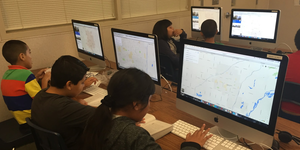
Servant Leadership
Open up a news app or social media stream and it becomes clear that we are living in a world that lacks empathy. We ask students to engage in respectful discourse, to back up their claims with evidence, but do we practice what we preach? Leadership is about service. It is very easy to judge what we do not fully understand. It is only through stepping into the shoes of those we serve that we are able to meet people where they are at and affect change.
What is Empathy?
Brene Brown’s 2:53 minute video clip regarding empathy provides insight into what it means to show empathy, as opposed to sympathy.
Empathy requires that we climb into the pit with our people, that we join them in their work, that we listen so intently that we are not planning how to respond before they have finished expressing their thought. I have found that when I begin with empathy, I am better able to support teachers and students.
The Benefits of Being There
As an educational consultant, I insist on being in classrooms with the teachers I serve as often as possible. I want to meet them where they are at, to build empathy in order to best support them. The better I understand the context of each individual’s work, the better I am able to serve them in a way that best meets their personal needs. My first year out of the classroom I purchased Airserver for all the teachers at my school site, an app that allowed them to mirror their iPad through their computer to be projected for the entire class to see.

This enabled teachers to circulate the room during instruction, so that they could be amongst their students during learning rather than at the front of the room. A few teachers began using the app immediately.
In walking into classrooms one week, I noticed that in many of the classrooms, Airserver was not being utilized. Realizing that a single walkthrough is not enough evidence to make a snap judgment, I tucked this observation into my mind for future reference. As I continued to walk classrooms each day, I continued to see this trend, particularly in one hallway. I asked one of our teachers if there was a problem with the software. The teacher remarked that the wifi had become so unstable that the app was rendered nearly useless. With this information in hand, I was able to investigate further, contact IT, and resolve the problem for the benefit of those I served. Part of this investigation included attempting to connect to the wifi with my own iPad in each of the classrooms, and recording the results to report to IT.
If I had not walked classrooms with an observant eye, I would not have had the opportunity to support those I served quickly. I am in classrooms across my county and have spoken to countless teachers that complain about the wifi. When I ask them if their leaders are aware, most teachers give up hope after one email or a couple of conversations. The technology becomes used less and less due to this frustration. Then leaders wonder why the devices they purchased lay idle in a cart on the side of the room.
Leaders – you must be in classrooms if you are to truly understand how to support your teachers. Formal evaluations once every year or two are not nearly enough time to allow you to learn about what your teachers need. Conversations alone do not build empathy for your teachers. If you want to affect positive change, you must join teachers in the classroom. You must be there. Presence is vital.
Do You Remember What It Is Like to Be a Teacher? Or a Student?
A computer lab on campus was used daily throughout the day by a number of teachers on a rotating schedule. I had noticed that student distraction and time off task increased significantly in this space, but I could not identify the reason. Teachers were perplexed as well. In our second semester, I had the opportunity to teach a class of 4th and 5th graders in the computer lab a couple of times a week. It was not until I began to teach this class that I made a discovery…the lab was set up in such a way that it was nearly impossible to see all of the students’ faces when giving directions.

The large computer screens blocked their vision. This may seem like an obvious problem, but it did not become clear until I began teaching in the space myself. Our minds can become so inundated with our work that the most clear reasons for a problem are sometimes not seen until we step into the shoes of those who are struggling. As a result of this discovery, I collaborated with teachers to design a new arrangement that worked for this shared space. Sure enough, student attention to learning increased and teachers were more relaxed in the space. Leaders – never forget what it is like to be a teacher.
Teachers, do not forget what it is like to be a student. Shadow those you serve, listen without judgment, join them in their space. We are in the business of supporting others. Take the time to be present with your people.
